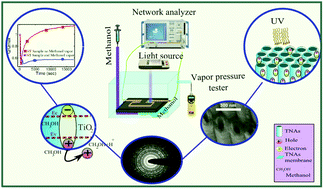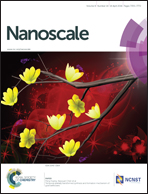Selective microwave sensors exploiting the interaction of analytes with trap states in TiO2 nanotube arrays†
Abstract
Sensing of molecular analytes by probing the effects of their interaction with microwaves is emerging as a cheap, compact, label-free and highly sensitive detection and quantification technique. Microstrip ring-type resonators are particularly favored for this purpose due to their planar sensing geometry, electromagnetic field enhancements in the coupling gap and compatibility with established printed circuit board manufacturing. However, the lack of selectivity in what is essentially a permittivity-sensing method is an impediment to wider adoption and implementation of this sensing platform. By placing a polycrystalline anatase-phase TiO2 nanotube membrane in the coupling gap of a microwave resonator, we engineer selectivity for the detection and differentiation of methanol, ethanol and 2-propanol. The scavenging of reactive trapped holes by aliphatic alcohols adsorbed on TiO2 is responsible for the alcohol-specific detection while the different short chain alcohols are distinguished on the basis of differences in their microwave response. Electrodeless microwave sensors which allow spectral and time-dependent monitoring of the resonance frequency and quality factor provide a wealth of information in comparison with electrode-based resistive sensors for the detection of volatile organic compounds. A high dynamic range (400 ppm–10 000 ppm) is demonstrated for methanol detection.

- This article is part of the themed collection: Editor’s Choice: Making sense of nanosensors and devices

 Please wait while we load your content...
Please wait while we load your content...